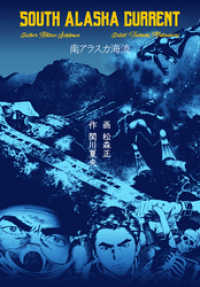- ホーム
- > 洋書
- > ドイツ書
- > Mathematics, Sciences & Technology
- > Biology
- > zoology
Full Description
Horseshoe crabs, those mysterious ancient mariners, lured me into the sea as a child along the beaches of New Jersey. Drawn to their shiny domed shells and spiked tails, I could not resist picking them up, turning them over and watching the wondrous mechanical movement of their glistening legs, articulating with one another as smoothly as the inner working of a clock. What was it like to be a horseshoe crab, I wondered? What did they eat? Did they always move around together? Why were some so large and others much smaller? How old were they, anyway? What must it feel like to live underwater? What else was out there, down there, in the cool, green depths that gave rise to such intriguing creatures? The only way to find out, I reasoned, would be to go into the ocean and see for myself, and so I did, and more than 60 years later, I still do.
Contents
Biology.- Limits on the Global Distribution of Horseshoe Crabs (Limulacea): Lessons Learned from Two Lifetimes of Observations: Asia and America.- Horseshoe Crabs - An Ancient Ancestry Revealed.- The Ecological Importance of Horseshoe Crabs in Estuarine and Coastal Communities: A Review and Speculative Summary.- Relationships Between Sandpipers and Horseshoe Crab in Delaware Bay: A Synthesis.- Horseshoe Crabs, Their Eco-biological Status Along the Northeast Coast of India and the Necessity for Ecological Conservation.- American Horseshoe Crabs, Limulus polyphemus, in Mexico: Open Possibilities.- Basic Habitat Requirements of the Extant Species of Horseshoe Crabs (Limulacea).- The Relationship Between Small- and Large-Scale Movements of Horseshoe Crabs in the Great Bay Estuary and Limulus Behavior in the Laboratory.- Ecology of Horseshoe Crabs in Microtidal Lagoons.- Phylogeography, Demographic History, and Reserves Network of Horseshoe Crab, Tachypleus tridentatus, in the South and East China Seaboards.- Genetic Structure of Japanese Populations of Tachypleus tridentatus by mtDNA AT-Rich Region Sequence Analysis.- Reproductive Competition and Sexual Selection in Horseshoe Crabs.- Vision in Horseshoe Crabs.- Sperm Attachment on the Egg of Malaysian King Crab, Carcinoscorpius rotundicauda.- Distribution and Development of Limulus Egg Clusters on Intertidal Beaches in Delaware Bay.- Comparisons in Prosomal Width and Body Weight Among Early Instar Stages of Malaysian Horseshoe Crabs, Carcinoscorpius rotundicauda and Tachypleus gigas in the Laboratory.- Emergence Behavior of Juvenile Tachypleus tridentatus Under Simulated Tidal Conditions in the Laboratory and at Two Different Sediment Temperatures.- Distribution of Juvenile Horseshoe Crabs in Subtidal Habitats of DelawareBay Using a Suction-Dredge Sampling Device.- Conservation.- History of Horseshoe Crab Harvest on Delaware Bay.- Biomedical Applications of Limulus Amebocyte Lysate.- The Effect of Hemolymph Extraction Volume and Handling Stress on Horseshoe Crab Mortality.- Horseshoe Crabs in Hong Kong: Current Population Status and Human Exploitation.- Comparative Status and Assessment of Limulus polyphemus with Emphasis on the New England and Delaware Bay Populations.- An Integrative Approach to Horseshoe Crab Multiple Use and Sustainability.- Strategies to Conserve and Enhance Sandy Barrier Habitat for Horseshoe Crabs (Limulus polyphemus) on Developed Shorelines in Delaware Bay, United States.- Conservation Program for the Asian Horseshoe Crab Tachypleus tridentatus in Taiwan: Characterizing the Microhabitat of Nursery Grounds and Restoring Spawning Grounds.- The Effects of Water Quality on Horseshoe Crab Embryos and Larvae.- Heavy Metal Concentration in Horseshoe Crab (Carcinoscorpius rotundicauda and Tachypleus gigas) Eggs from Malaysian Coastline.- A Discussion of Horseshoe Crab Management in Five Countries: Taiwan, India, China, United States, and Mexico.- Clinical Evaluation, Common Diseases, and Veterinary Care of the Horseshoe Crab, Limulus polyphemus.- Aquaculture Methods and Early Growth of Juvenile Horseshoe Crabs (Limulus polyphemus).- Larval Culture of Tachypleus gigas and Its Molting Behavior Under Laboratory Conditions.- Diet Composition of Juvenile Horseshoe Crabs: Implications for Growth and Survival of Natural and Cultured Stocks.- Effect of Sediment Type on Growth and Survival of Juvenile Horseshoe Crabs (Tachypleus tridentatus).- The Conservation Network of Horseshoe Crab Tachypleus tridentatus in Taiwan.- The History of Horseshoe Crab Research and Conservation inJapan.- Public Awareness and Community-Based Conservation for the Horseshoe Crab at Saikai National Park in Nagasaki Prefecture, Japan.- Public Participation in Studies on Horseshoe Crab Populations.- Green Eggs and Sand: A Collaborative Effort of Scientists, Teachers, Resource Managers, and Stakeholders in Educating About Limulus polyphemus.- Community Building: An Integrated Approach to Horseshoe Crab Conservation.








